Mainelining - Part II
If you missed part 1 you can check it out here
So if you haven't already done a Google search on it you're probably wondering just what exactly the reversing falls are. Well, just sit right back and I'll tell you.
For starters I think “reversing falls” is a bit of a misnomer. While it really is an impressive site it's more like a series of standing waves rather then actual “falls”. It's caused by the constantly changing current as the tide goes in and out. You see, the east coast (at least up there) isn't really like the west coast where it's pretty much just a straight line. The down east Maine coast is very crooked and jagged with lots of bays and inlets. Couple that with the very rocky terrain and you get lots of little islands, cliffs, points, and narrows in these inlets.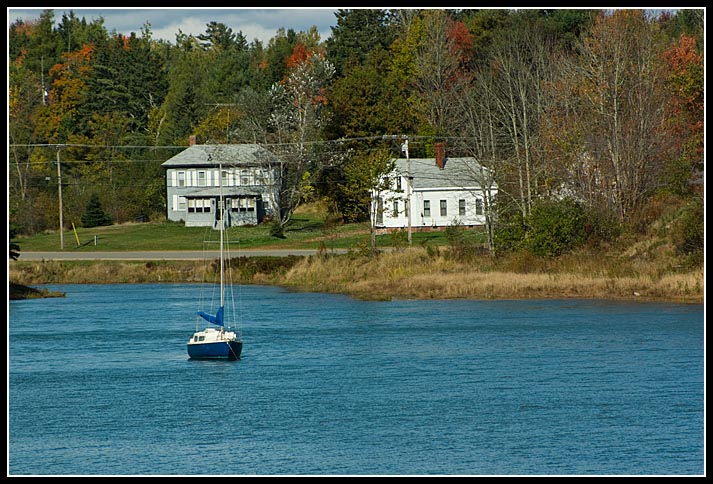 Now when you throw the tides into the mix you've got a heck of a lot of water being forced through some pretty narrow passage ways. You see, the tides up here are pretty massive. When I was in the PNW
Now when you throw the tides into the mix you've got a heck of a lot of water being forced through some pretty narrow passage ways. You see, the tides up here are pretty massive. When I was in the PNW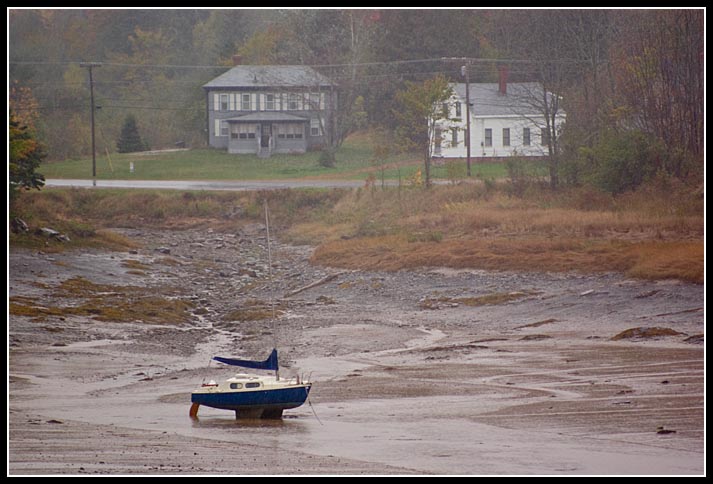 a pretty good tide change had a difference of about 8 feet between high and low tide, many places were less then that. But around the Pembroke and Eastport area the difference between high and low tide is about 20 feet. That means if you were standing on the edge of a cliff at high tide and the water was lapping at your toes then at low tide the water would be 20 feet below you. So you can imagine how much water must be flowing during the tide changes.
a pretty good tide change had a difference of about 8 feet between high and low tide, many places were less then that. But around the Pembroke and Eastport area the difference between high and low tide is about 20 feet. That means if you were standing on the edge of a cliff at high tide and the water was lapping at your toes then at low tide the water would be 20 feet below you. So you can imagine how much water must be flowing during the tide changes.
What actually causes the reversing falls is a narrow channel between two points of rocky land that the water is forced to flow through, making for some hellacious current. At high tide, just below the surface are a few submerged islands and bars. When the water really starts to whip through the channel these underwater islands really disrupt the current and cause some big rapids and standing waves (reversing falls). As the tide gets lower these islands eventually poke their heads above water where they get to soak up the sun for a few hours before being submerged again. The whole process makes it look like a totally different place at high and low tides.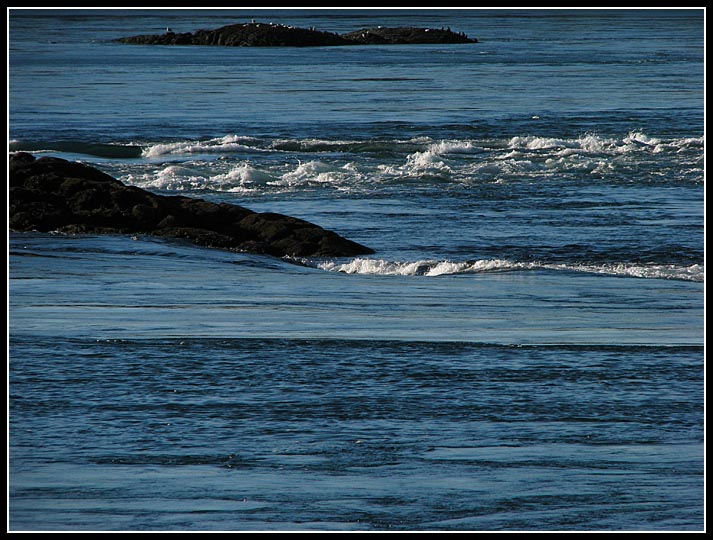 The moving water is nearly constant 24 hours a day too; it's like camping next to a rushing river, the roar is constantly in the background. As the tide comes in or out it gradually builds up speed until it's a rushing torrent with rapids, eddies, small whirlpools and huge boils of water thrust up from underwater rocks and cliffs. Then as the inlet begins to fill up/empty the water begins to gradually slow down until all of a sudden you notice it's quiet for the first time in hours and the water is still. It gets very peaceful and you can hear the lobster boats in the distance. You can hear the sea gulls chatting away on the newly uncovered islands and you can hear the seals flopping around and forcefully expelling air through their nostrils. You just sit on the jagged rocks and it's like looking out onto a peaceful lake. You see a bald eagle soaring above the trees and you hear the little squirrels and chipmunks scurrying around in the woods behind you.
The moving water is nearly constant 24 hours a day too; it's like camping next to a rushing river, the roar is constantly in the background. As the tide comes in or out it gradually builds up speed until it's a rushing torrent with rapids, eddies, small whirlpools and huge boils of water thrust up from underwater rocks and cliffs. Then as the inlet begins to fill up/empty the water begins to gradually slow down until all of a sudden you notice it's quiet for the first time in hours and the water is still. It gets very peaceful and you can hear the lobster boats in the distance. You can hear the sea gulls chatting away on the newly uncovered islands and you can hear the seals flopping around and forcefully expelling air through their nostrils. You just sit on the jagged rocks and it's like looking out onto a peaceful lake. You see a bald eagle soaring above the trees and you hear the little squirrels and chipmunks scurrying around in the woods behind you. This lasts for about 10 minutes before you start to notice the water swirling the other way. It gradually starts to pick up speed and before you know it there's a raging river in front of you again. The cormorants and seals don't seem to be bothered by it at all. You see the seals floating along through the ugliest looking currents just as calm as can be. They stick their heads under water like they're looking for fish and then dive out of site, only to reappear a few seconds later 500 feet away. As you watch them you wish that you could be as comfortable in the water as they are and then you wonder if they think the same thing as they watch you walk about on the land. It's mesmerizing to sit on the rocks and watch the water sweep by as you watch the waterscape change right before your eyes. You know that the rock you're sitting on, 10 feet above the water line, will be submerged in just a couple of hours.
This lasts for about 10 minutes before you start to notice the water swirling the other way. It gradually starts to pick up speed and before you know it there's a raging river in front of you again. The cormorants and seals don't seem to be bothered by it at all. You see the seals floating along through the ugliest looking currents just as calm as can be. They stick their heads under water like they're looking for fish and then dive out of site, only to reappear a few seconds later 500 feet away. As you watch them you wish that you could be as comfortable in the water as they are and then you wonder if they think the same thing as they watch you walk about on the land. It's mesmerizing to sit on the rocks and watch the water sweep by as you watch the waterscape change right before your eyes. You know that the rock you're sitting on, 10 feet above the water line, will be submerged in just a couple of hours.
That's about all their is to see at the Reversing Falls park. It's a really nice place to check out though. It's not a park like you'd normally think of. There are a few camping sites but they're just spots people have built a fire ring next to a flat place to park or pitch a tent. There are no interpretive signs, paved roads, or any little things to entertain the kiddies. You just pull into the small gravel parking lot and walk around.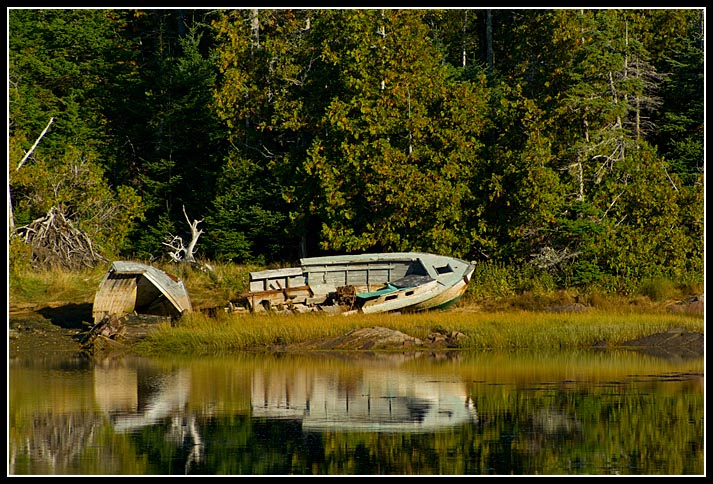 There is however a nice trail that winds through the woods and follows the shoreline. It's not really long but it leads you out to a couple small, rocky points for a different view of the area and also leads you past a couple of wrecked boats along the shoreline. I can remember walking this trail a couple years ago when I was out here. It amazed me at the time, it was the first time I'd ever really walked through a pine forest. I couldn't believe how moist everything seemed to be and how soft the ground was with pine needles. The pine trees were really dense and they all had this moss growing on them.
There is however a nice trail that winds through the woods and follows the shoreline. It's not really long but it leads you out to a couple small, rocky points for a different view of the area and also leads you past a couple of wrecked boats along the shoreline. I can remember walking this trail a couple years ago when I was out here. It amazed me at the time, it was the first time I'd ever really walked through a pine forest. I couldn't believe how moist everything seemed to be and how soft the ground was with pine needles. The pine trees were really dense and they all had this moss growing on them.
While I still think it's a nice little trail it doesn't seem so impressive or new anymore. Hiking in the rain forest at Olympic National Park takes some of the edge off many hikes in the woods now. Still, it's a nice trail and I walked it more then a few times on my stay. Most people don't take the time to walk the trail so when a few people are crowded around the parking area all it takes is a short 10 minute walk and you're all by yourself on a little rock out cropping.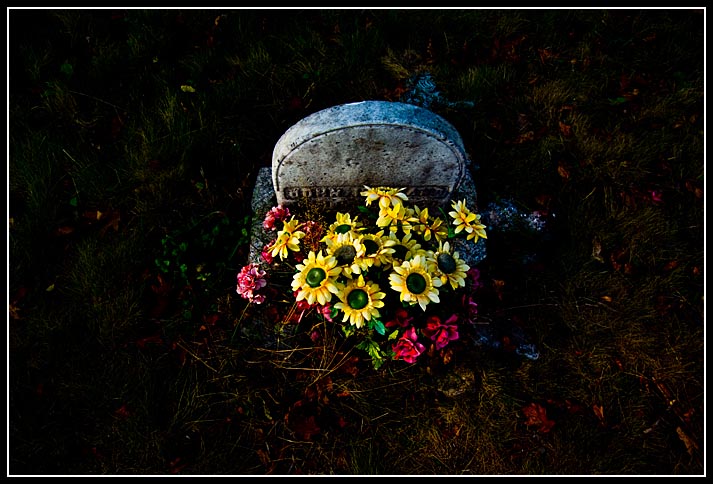 There must have been a homestead on the place once upon a time. In one corner of the park stands a small, roped off cemetery with a few headstones in it. They're all very old and a couple have been vandalized. All that's left of one appears to be the base while another looks like it's been shot at a time or two and broken off and then propped back up. A couple of them have a few fake flowers around them that are who knows how old. I wonder if they were actually placed there by family or if someone just thought it would look nicer. They're old and ratty looking enough now that they make it look a little creepy.
There must have been a homestead on the place once upon a time. In one corner of the park stands a small, roped off cemetery with a few headstones in it. They're all very old and a couple have been vandalized. All that's left of one appears to be the base while another looks like it's been shot at a time or two and broken off and then propped back up. A couple of them have a few fake flowers around them that are who knows how old. I wonder if they were actually placed there by family or if someone just thought it would look nicer. They're old and ratty looking enough now that they make it look a little creepy.
Another clue that there was a homestead is all the apple trees in the area. All of them are now neglected and look pretty poorly. They were fully of apples while I was there and many had already fallen on the ground. I thought of trying some but most didn't look too appealing. Some of the trees are in nice lines out in the open but others seem to have been swallowed up by the forest and are somehow managing to still survive. It's odd to be walking through the dense woods and suddenly see a few apples hanging from a limb. The trees in the woods are poor, spindly looking things. The small pines have grown in so thick it's very difficult even to walk around; I can't imaging the small apples trees get much sun, they don't stand a chance.
Just a little ways into the woods you also find what looks to be the remains of a short, stone wall. I looked around for any signs of old foundations from a house or barn but didn't see anything. I thought I had for a while but the more I looked I think it just may have been a large outcropping of rocks; though it did look like it would make a great corner to a foundation. While walking back into the woods a little bit I did run across an old fire ring that didn't look like it had been used in years. I'm sure it wasn't left over the from homestead but it was a sign that where I was wasn't quite so overgrown at one time.
It was just a small circle of rocks, all of which were now nearly covered by the earth with just the top half of them sticking out. The whole thing was covered with many layers of pine needles and there were a couple small pines growing up from the center of the ring. There was one small piece of wood left from the last fire the ring had seen. It was black on the top from being burned but it didn't have that burned look to it anymore. It had been weathered enough that it just looked like someone had painted part of it black, it was the same texture as the rest of the wood. I picked it up and found there was hardly anything left of it. It was nearly rotted away and weighed next to nothing. It was a lot more charred underneath. Lots of bugs and mold had made their homes under it and were none too happy with me for picking up their house. I set it back down in the same place I'd picked it up. I looked around the campsite for some sign of it's previous use but found nothing other then a cigarette butt. I don't know if it's from someone that had a fire there or just someone that dropped one while walking through. I did do a little research and found it takes a long time for a cigarette butt to break down. The general consensus seems to be from 2-25 years depending on conditions.
For the most part the reversing falls is a really nice place to hang out. Few people come back to check it out and most don't stay very long. The whole area, while not exactly remote, is pretty rural. The towns are very small with nothing but a convenience store if you're lucky. Most of the towns don't have anything resembling a downtown; the houses seem to be spread out a little more. I always thought the coast line would have lots of big, fancy houses along it but I found that's not the case, at least not up here. The shoreline is mostly just forest and most of the houses you do see along the coast are very modest, definitely a pleasant surprise. Yes, a good place indeed to spend a week or so just relaxing.
Yes, a good place indeed to spend a week or so just relaxing.
To be continued-again
If you'd like to see some pictures showing the difference between high and low tides you can check out this Flickr set
No comments:
Post a Comment